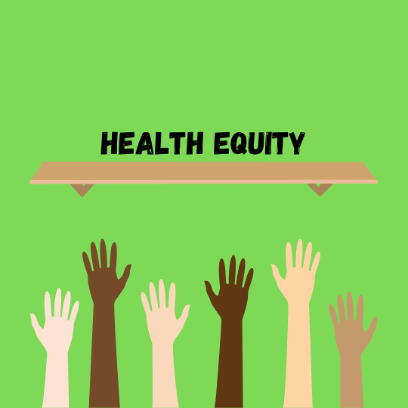
“Health equity is achieved when everyone can attain their full potential for health and well-being” – CDC
April is National Minority Health Month, a time to reflect and build awareness around the inequities that continue to negatively impact the health outcomes of racial and ethnic minority groups.
In the United States, racial and ethnic minority groups experience higher rates of illness and deaths related to chronic diseases, such as diabetes, hypertension, obesity and heart disease. In the healthcare setting, providing culturally and linguistically appropriate information to patients from minority populations including American Indian/ Alaska Native (AIAN) communities, is critical for improving health outcomes and promoting health equity. However, achieving health equity requires more than providing healthcare coverage for all, it requires the dismantling of long-existing structural bias, systemic racism, and social disparities that continue to create challenges for minorities in accessing equitable and high-quality healthcare.
What is Structural Bias?
Structural bias is defined as “the institutional patterns and practices that confer advantage to some and disadvantage to others based on identity”. Structural bias within the healthcare system makes quality healthcare less accessible to minorities. Like many minorities in this country, my mother continually experiences challenges navigating the healthcare system to obtain only adequate medical care. As an immigrant, monolingual Spanish-speaker with limited computer skills and knowledge of how the healthcare system operates, she is more likely to have difficulty obtaining quality care than someone who speaks English, owns a car, and can easily access and manage their medical records online.
My most recent encounter with structural bias happened while assisting my mother in scheduling a time sensitive procedure at a specialty clinic. What should have been a simple task became a series of arduous steps: scheduling, obtaining a medical clearance, requesting a renewal of an expired specialist referral, calling and sending messages back and forth to confirm receipt of the medical clearance, and finally after all that, scheduling the procedure (which also happened to be three cities away).
Fortunately, I can advocate for my mother. I’m able to assist her in scheduling her procedure and drive her to and from the clinic site this month, but what about others who might not have someone to help navigate the health system and advocate for their health? How would they be able to obtain care in a convoluted healthcare system that is not designed to meet their needs?
The intersection of Structural Bias, Social Inequities, and Systemic Racism in Healthcare
Structural bias is inextricably linked and intersects with two other factors that further hinder access to quality and equitable healthcare: social inequities and systemic racism.
Social Inequities refer “to differences stemming from race/ethnicity, access to educational opportunities, and socioeconomic status, which may lead to poor housing conditions, less awareness about access to health care, and inferior health outcomes.” In my mother’s case, she had limited educational opportunities which may have helped her learn how to use a computer or how to drive. Education happens to be one of the Social Determinants of Health that contributes to inequities in health outcomes. While access to high quality healthcare is only one aspect of health equity, the lack of consideration for social inequities experienced by minority populations in the design of healthcare delivery, amplifies structural bias in the healthcare system, in favor of more privileged groups.
Systemic racism is a “form of racism that is deeply embedded in systems, laws, written or unwritten policies, and entrenched practices and beliefs that produce, condone, and perpetuate widespread unfair treatment and oppression of people of color, with adverse health consequences”. Like many minorities in this country, my mother has also experienced some form of discrimination in healthcare that may not have been apparent at first, but became clear when she switched insurance and healthcare providers. Years ago while receiving care, my mother was told her heart rate was lower than normal, but no additional follow up was conducted at the time. Once she switched to her new health care provider, they not only noted the abnormal heart rate, but also mentioned that the issue should have been addressed sooner and that she now required a pacemaker. When I spoke to others about their experience with the former healthcare provider, all expressed satisfaction with the quality of care, but those I asked also happened to be non-minorities. I couldn’t help but wonder whether my mother’s health was affected by neglect, or if racism could have played a role as well.
My mother’s experience is only one of many. Racism in healthcare is evident in the form of health disparities by race and ethnicity. For example, “American Indian/Alaskan Native (21%) and Hispanic (19%) people were more than twice as likely as their White counterparts (7%) to be uninsured as of 2021”, and “among adults with any mental illness, Black (39%), Hispanic (36%), and Asian (25%) adults were less likely than White (52%) adults to receive mental health services as of 2021.” It is no coincidence that healthcare access varies by race and ethnicity, when systemic racism remains pervasive within the healthcare system and intersects with structural bias and social disparities that create additional barriers for minority and vulnerable populations.
What can be done?
Achieving health equity within communities and larger systems of care will require methods that address structural bias, social inequities, and racism, that currently hinder progress towards equitable health. The presence of health disparities by race, ethnicity, and socioeconomic status are unacceptable and indicate that more must be done to ensure that everyone regardless of their background and life experiences can have the opportunity to thrive physically, mentally, and socially. Health equity should be a priority not only for the sake of minorities that are negatively impacted by health disparities, but for our society as a whole because optimal health for all communities supports a thriving and equitable society for years to come.
By Laura Campos, Associate Project Manager – Intern, for HOP’s series of monthly staff blogs.
